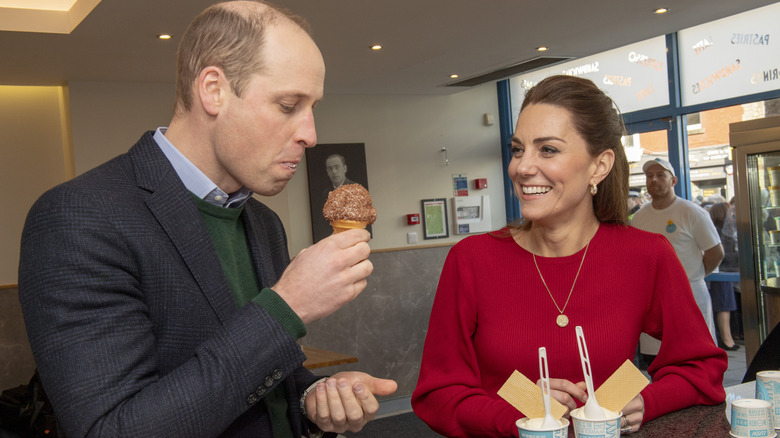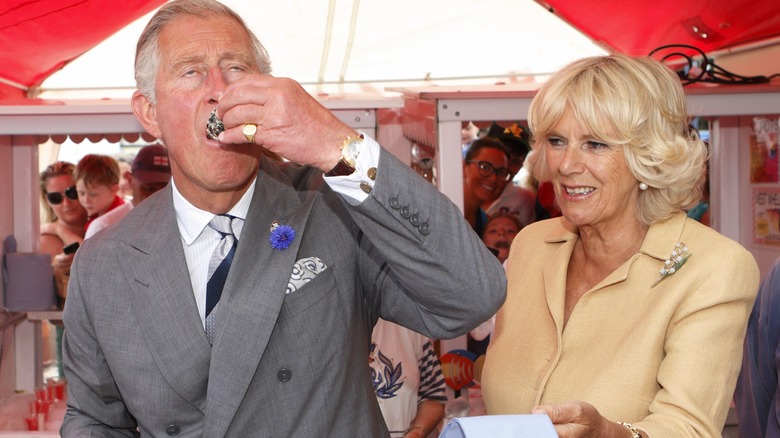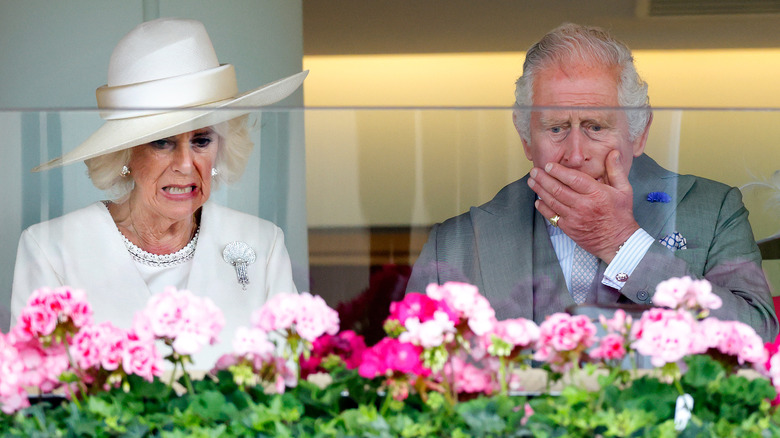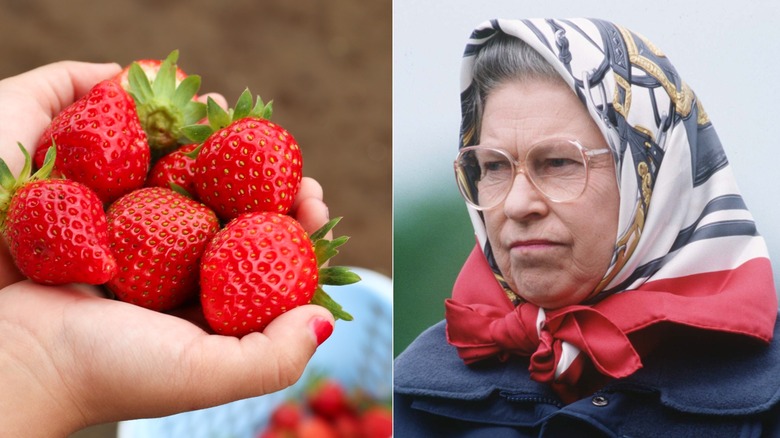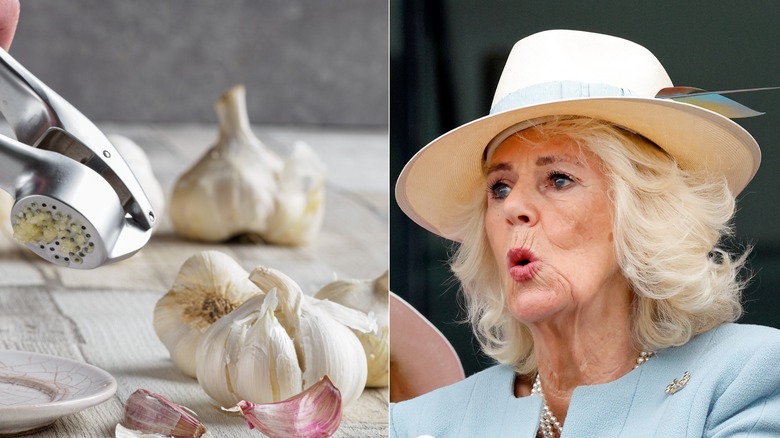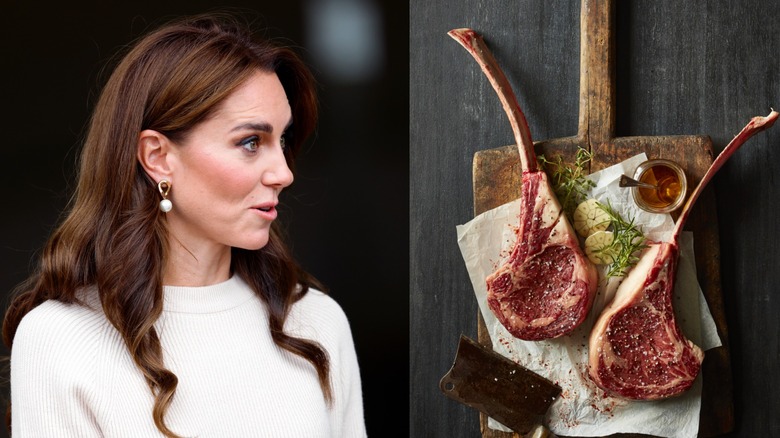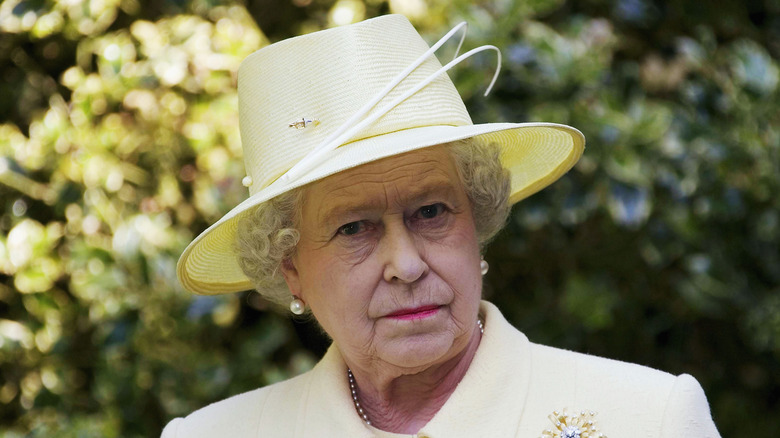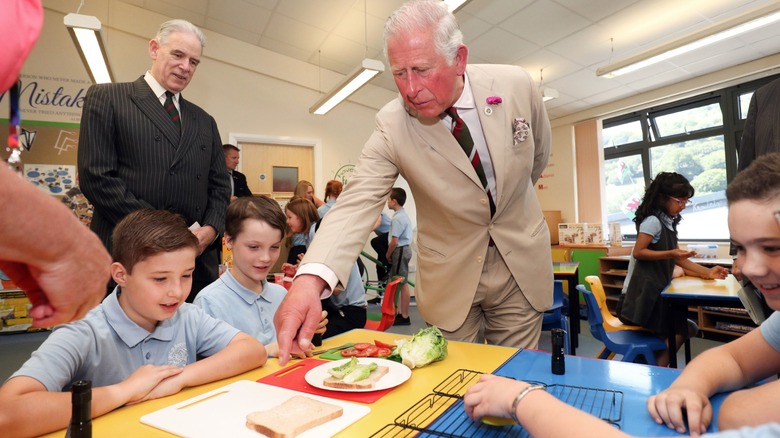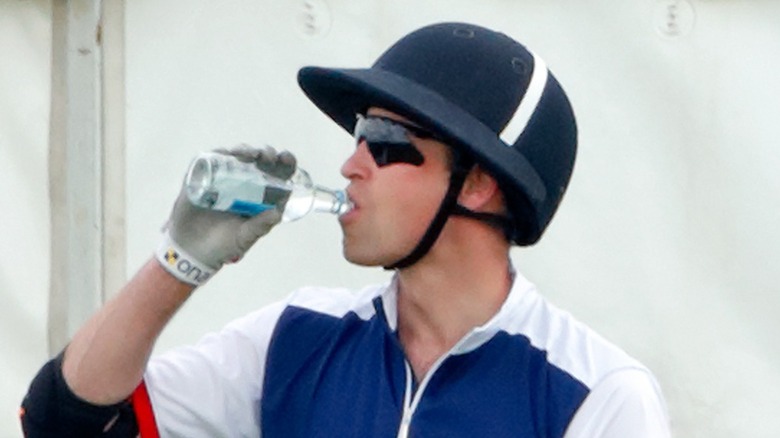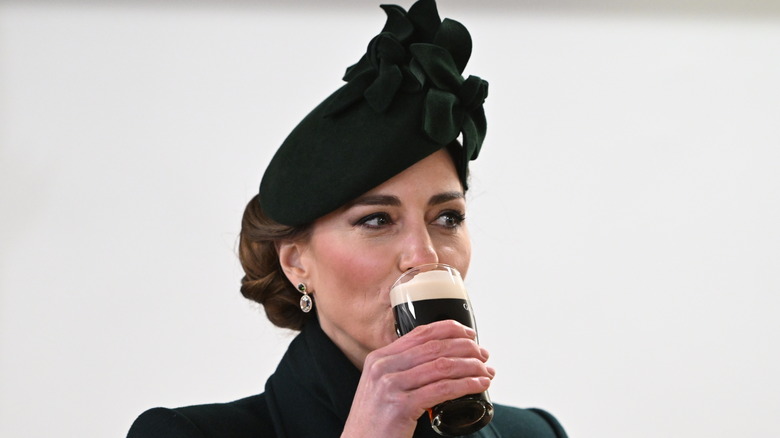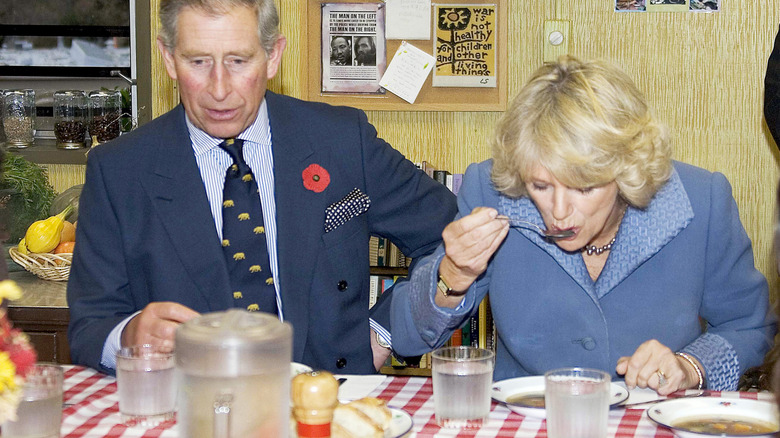13 Foods You Will Never See The Royal Family Eat
We may receive a commission on purchases made from links.
From a distance, the British royal family appear to have privileged lives but, as we know all too well, being part of "the firm" can be a gilded cage. For all the finery and luxury that surrounds them, there are more rules for working royals than most of us would tolerate for longer than a few hours.
Thanks to their world-famous faces, everything they say and do is scrutinized, and they cannot be seen to be putting a foot wrong. Protocol, often based on the way things have been done for centuries, dictates how a senior royal figure should behave in public — including what they eat and drink.
Some of the rules they follow are understandable, others not so much, but all have the same underlying reason: To keep the various members of the House of Windsor safe. With that in mind, here's a look at 13 items you'll never see the royal family eat or drink.
Shellfish
Seafood can be a menu game changer for some people and a dealbreaker for others. Anyone who has whipped up a shrimp cocktail with a nod to Ina Garten knows it's nutritious, delicious, and versatile. There is a darker side to seafood. It can also be the source of several toxins –while symptoms, including vomiting and diarrhea, can kick in within 30 minutes.
It's no surprise to learn it will never appear on a royal menu, either at Buckingham Palace or on tour. Grant Harrold, former royal butler, told The Express: "When dining, the royal family has to be careful with shellfish due to shellfish poisoning, due to their work schedules."
Ironically, whenever the Queen Mother stayed at London's The Goring Hotel, she always ordered a crabmeat and lobster-based dish called eggs Drumkilbo, and in 2018, during the opening of Japan House in London, Prince William admitted he and his wife were big fans of sushi.
Spicy food
The dietary rules of the British royal family can seem a little odd, but in some cases there's a good excuse why certain foods are off the menu. Spicy recipes of all kinds are a no-no for senior members of the House of Windsor, for two reasons: First, the possibility of an upset stomach during any kind of public engagement is too great.
Second, the royals have an image to uphold, and digestive disruption is not part of it. You've never heard a royal burp in public because they're not allowed anywhere near spicy food. In private, it's a different matter. Prince Philip loved indulging in a good curry, according to former royal chef Darren McGready, but only when Queen Elizabeth was away on official engagements.
In 2017, while appearing on the BBC 1 radio show "Going Home with Vick and Jordan," William and Kate revealed they would probably be having curry for dinner that night, per Vanity Fair. It emerged that he doesn't like it hot. "I can't do too much spice. I start sweating. It's not attractive," he said. Kate adds more spice after giving William his plate, but Princess Charlotte seems to be a chip off the old block, according to a Daily Mail post on X.
Exotic food when outside the UK
The British monarch heads the Commonwealth, an organization created in 1949 and made up of 56 countries. Many royals have visited them all on several occasions, and other nations besides, making the House of Windsor a very well-traveled bunch. These trips, from months-long overseas tours to shorter state visits, are meticulously choreographed down to the finest detail, including what they can — and cannot — eat.
Royal visits are often about shedding light on other cultures, as a 2025 celebration of all things Italian ahead of a state visit proved. As such, foods that might never see the light of day in the United Kingdom could be served to the Windsors, but royal protocol forbids it. Anything exotic, quirky or just plain strange that could potentially make a royal guest sick or embarrassed is likely to be hastily scrubbed from the menu at the planning stage, saving everyone from getting, well ... egg on their faces.
Unseasonal food
While protocol can restrict what members of the royal family eat when they're in public, sometimes their own personal tastes can provide limits too. King Charles doesn't like coffee or chocolate, so he is unlikely to be served them. Staff must also keep a warming pan to hand so the monarch doesn't have cold cookies. Quirks aside, food served out of season is another royal no-no.
For Queen Elizabeth, one fruit especially would be struck off a menu if they weren't in season. Former royal chef Darren McGrady said, per Readers' Digest: "Try including strawberries on the menu in January and she'll scrub out the line and say 'don't dare send me genetically modified strawberries'." As for King Charles, his passion for seasonal eating and organic food was established long before it became a trend. In his book "Cooking & the Crown," the King's son-in-law Tom Parker Bowles wrote that the monarch's pantry is full of "seasonal bounty of the royal estates."
Garlic or onions
British royals don't eat certain foods to avoid getting sick — they are a working family after all. But some ingredients are off the menu because of their jobs. Senior royals are not only patrons of many charities, they also act as ambassadors for the United Kingdom. That means meeting and greeting everyone from small children to heads of state, so fresh breath is a must. In a common-sense rule said to have come from Queen Elizabeth, there can be zero garlic in their food, and not too much onion.
Avoiding garlic isn't a problem for King Charles as he doesn't like it, but for Queen Camilla, it's more a gesture of courtesy. In 2018, "MasterChef Australia" judge Gary Mehigan asked what she would least like to see on a tray of canapés and she replied: "I hate to say this but garlic," per Daily Mail. The reason? Because the royals are always chatting to people. Or she could try these two ways to get rid of the smell.
Raw meat
Royal tours are a fact of life for senior members of the House of Windsor. As Queen Elizabeth regularly said: "We have to be seen to be believed." Traveling the world brings them up close to different cultures and foods — but not everything is on the menu. Protocol, not to say basic health and safety, forbids raw meat to be served to visiting royals due to the risks of them falling sick.
There are several foodborne illnesses linked to raw meat, including Salmonella, E. coli, and campylobacter. Going down with any of those could throw into chaos a carefully planned royal itinerary. The rule also extends to rare meat, which carries a similar amount of risk. Despite their public limitations, the royals are enthusiastic meat eaters. Kate admitted to loving kidneys during a 2023 visit to the Oxford House Nursing Home – and, in his day, Prince Philip was the grill master of all the family barbecues.
Pasta, potatoes, and starchy foods
Queen Elizabeth II reigned for almost 71 years and ruled her family's eating habits with a rod of iron for much of that time. Among the restrictions she imposed was a ban on pasta, and for fairly logical reasons. In 2000, a BBC News report revealed that, ahead of a state visit to Italy, "long pastas and 'messy' tomato sauces" would be off the menu.
The lack of pasta wouldn't be a problem for the Queen, who was not a fan, according to former royal chef Darren McGrady. He told The Telegraph in 2015: "No starch is the rule. No potatoes, rice or pasta for dinner." Princess Kate has followed a similar dietary path, but while chatting to a patient at Great Ormond Street Childrens' Hospital in 2018, she revealed that Charlotte was a pasta fan. In a separate visit to Lavender Primary School in London, Kate also said her daughter, George, and Louis all love making cheesy pasta at home.
Rounded sandwiches without crusts
Many of the protocols governing royal behavior are based on traditions that can date back hundreds of years. That includes the sandwich, according to former royal chef Graham Newbould. In the documentary "Secrets of the Royal Kitchen," he demonstrated how to make cucumber sandwiches fit for a King. As well as revealing the Windsors were never served any foods with seeds – presumably he knew about bananas — the teatime snacks were also presented in a very particular way.
First, they never have crusts. Former Buckingham Palace employee Owen Hodgson told The Telegraph how a "chef told me off for serving the sandwiches with crusts." Second, any square sandwiches always have their corners trimmed off, so they're almost round. Newbould said it was a long-standing tradition, explaining that "in the olden days" anything pointed that was served to the monarch meant they were at risk of being overthrown.
Tap water
Millions of people across the United States drink an array of bottled water brands thanks to concerns about chemical pollution. When traveling abroad, sidestepping the tap water in some countries can also be a wise health move. It's a similar story for the House of Windsor. They don't drink tap water even when they're in the United Kingdom. Instead, it's supplied by British companies.
Hampshire-based Hildon Natural Mineral Water is one. It has supplied the royal family's bottled water since 2019, while infamously, Princess Margaret demanded only the Malvern Water brand be used to dilute her Famous Grouse whisky. Occasionally her footman David John Payne would top it up with tap water and she never realized. Given the wide range of countries the royal family visit in the course of their work, their luggage includes a generous supply of bottled water, ensuring they never touch what comes out of a tap, wherever they are.
Alcoholic drinks from strangers
For centuries, being a monarch or the heir to a throne was tricky business. Enemies lurked in almost every corner and few people at court could be trusted, so food and drink tasters were not a perk of the job, they were essential if you wanted to live. Today, the threats to the House of Windsor may be no more serious than dodging eggs thrown by angry protesters – and while they don't have food tasters, they do have strict rules to keep them safe.
Senior royals are old hands when it comes to mixing with the public in various settings, but they are not allowed to accept alcoholic beverages from strangers, especially if they haven't seen them being poured out. The reason is pretty straightforward and applies to anyone who wants to enjoy a good time. The risk of the drink potentially being spiked with something that could make a royal sick — or worse — is simply too high.
Food outside a royal setting unless approved
Protocol, etiquette, and common sense are behind the web of sometimes strange rules that members of the British royal family have to live by — at least when they are on duty. One of the strangest involves what they can and can't eat in a formal, public setting. The working royals are sought-after or popular guests at charity events, along with school and hospital visits.
On the occasions where food and drink are involved – visiting a pub, for example — the royal VIP will only eat or drink items that have been pre-approved within that location. If someone tries to give them something, say as a gift, on the way in or out, they cannot accept it. While that seems sensible enough, there's a flip side. If a member of the royal family is offered any food or drink within the approved setting, they must eat it. Presumably the meticulous planning before any event weeds out anything the royals don't like.
Foie Gras
Being a member of the royal family means living on a scale of luxury most of us can only dream about: Should they want it, the best of everything is at their fingertips, and that includes food. However, one item that you'll never see any member of the royal family eating — at least in public — is foie gras.
Banned in lots of countries and made from the livers of geese and ducks, foie gras is considered a delicacy, but the way it is produced causes controversy. The birds are force fed by tubes, at least twice a day, so their livers swell. Charles is deeply opposed to the production of foie gras and, since the early 2000s, has banned it from being served in any of his own properties. In November 2022, two months after he became King, Charles ordered the foodstuff removed from all royal households.
Finger foods
Queen Victoria reigned for just over 63 years, and had plenty of time to come up with rules, some of which bind the royal family to this day. One covered finger foods or, more particularly, eating meals with their hands. According to royal protocol, this could only be done when enjoying afternoon tea – any other time, cutlery must be used.
There have been a few occasions when the royals broke this Victorian tradition. In a 1980 state visit to Morocco, Queen Elizabeth was invited to eat with King Hassan II and, bowing to local custom, used her hands. Prince Philip did the same on another occasion. In 1984, during a state dinner, he sat next to a politician's wife who had been injured in the IRA bombing of the Grand Hotel in Brighton. When he realized she was struggling to eat, the Duke of Edinburgh ditched his cutlery and ate with his hands, allowing her to do the same.
